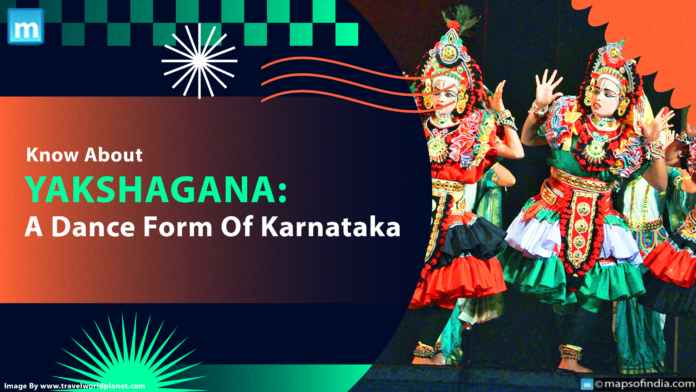Yakshagana is a traditional Indian dance genre from the Indian state of Karnataka. It is a multifaceted and visually appealing art form that mixes dance, music, and theatre. Yakshagana performances primarily reflect Hindu mythology, but they can also address current social and political issues.
History
Yakshagana is a traditional theatre form that emerged in the 15th century in the coastal districts of Karnataka, India. It is a one-of-a-kind combination of dance, music, speech, costume, make-up, and stage techniques. Yakshagana is thought to have arisen from pre-classical music and theatre during the Bhakti movement.
Yakshagana performances are usually several hours long and recount stories from Hindu mythology, epics, and folklore. The stories are told using a mix of song, dance, and discourse. The actors are dressed in elaborate costumes and make-up, and the stage is decked with a bright backdrop and props. It is a highly stylized art form, and the performers must undergo extensive training to learn the performance’s many components, including singing, dancing, acting, and makeup. Yakshagana is also a very collaborative art form, and the success of a performance is dependent on the collaboration of all participants.
Yakshagana was previously a widely popular art form in Karnataka, but its popularity has declined recently. However, a handful of Yakshagana troupes continue to perform regularly throughout Karnataka. Yakshagana is also gaining popularity among younger audiences, and several initiatives are underway to revitalise and promote this traditional art form.
Performance
Yakshagana performances are often staged in temples or open-air theatres. The stage is separated into two sections: the front stage, which houses the dancers and musicians, and the rear stage, which houses the costumes and props. Yakshagana’s dancers are dressed in fancy costumes and masks and perform a range of routines such as acrobatics and martial arts. Drums, flutes, and cymbals are among the instruments used by the musicians. Yakshagana’s singers are likewise quite talented. They sing in Kannada, the Karnataka language, and their songs tell the play’s tale.
Costume
Yakshagana’s outfits are ornate and bright. The dancers wear masks that depict the personalities they portray. The masks are often made of wood or papier-mache and are embellished with gems and feathers.
Music
Yakshagana’s music is lively and exciting. Drums, flutes, and cymbals are among the instruments used by the musicians. The singers sing in Kannada, Karnataka’s native language and their songs tell the play’s plot.
Themes
Yakshagana performances primarily reflect Hindu mythology, but they can also address current social and political issues. Among the most prominent Yakshagana topics are:
- The Ramayana: The story of Rama, his wife Sita, and his brother Lakshmana, the Hindu god.
- The Mahabharata: The battle between the Pandavas and the Kauravas.
- The Bhagavata Purana: The narrative of Krishna, the Hindu god.
This art form is conducted throughout the state in villages, towns, and cities. Outside of Karnataka, Yakshagana is performed in different areas of India and worldwide. Yakshagana is an essential element of Karnataka’s cultural history. It is a vibrant and dynamic art form that entertains and educates audiences today.




